I feel like crypto is about to have a big event. Something very bullish.
I'm not sure what will happen next, but the market has certainly changed significantly.
Interest rate cuts started, ETH ETF approved, BTC ETF inflows increased, Stripe launched stablecoin payments...
Just like an army prepares itself before a decisive battle, major crypto companies and TradFi are preparing for the upcoming bull run.
More posts about this "feeling" are below:
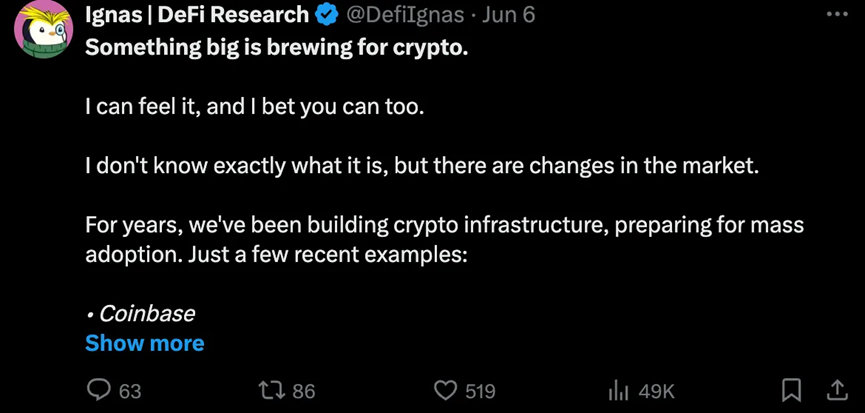
https://x.com/DefiIgnas/status/1798728401345515960
Meanwhile, the crypto machines inside haven’t stopped moving. Yes, prices are falling…
But markets are always changing, and as they grow and develop, new narratives and trends emerge that impact the market.
Just as MakerDAO launched before the term “DeFi” was coined, new trends are now emerging in the market that are still too small to form a coherent story.
Here are seven emerging trends that could have a big impact on the market and the top three airdrop farms for this week.
Best Airdrop Farms of the Week
1.Catalyst: A cross-chain AMM designed to connect different blockchains for cross-chain exchange and liquidity sharing. Powered by Wormhole.
•Currently only ETH swaps between Optimism, Blast and Base are available.
•On May 21, Catalyst launched Eggs Rewards, which will be distributed weekly for 10 weeks to reward users for their payment and exchange behaviors.
• Loyalty Score: Tracks your activity over time, from 0-100. Stay active to improve your score. While it doesn't affect the number of eggs you get, it does affect which eggs they hatch.

2. Farcaster: If you don’t know yet, you must be new to the crypto space. If you don’t have an account yet, you’re doing it wrong.
•Farcaster recently raised $150 million from Paradigm, a16z and others at a valuation of $1 billion.
•There are reports that Farcaster may issue tokens. Does this mean an airdrop?
3. Zircuit: The next big airdrop and token issuance of L2 may come soon. They seem to be too low-key.
It’s backed by Pantera and Dragonfly, and Binance just announced an investment. It integrates the main LRT protocol, so you can airdrop LRT+Zircuit at once. Deposit your LRT ETH to get 2x points. You can withdraw anytime.

I think DALL-E with ChatGPT 4o is finally getting better.
1. Repackaging
Old coins are boring, and degens want something new.
What if you could change your brand name, create a new token ticker, and start over with a fresh chart? That sounds a lot more exciting!
Fantom → Sonic
This is exactly what Fantom did with the Sonic upgrade.
Sonic is a new L1 with a native L2 bridge to Ethereum. It will have the new Sonic Foundation and Labs, and a brand new visual identity.
What’s more, the new $S token “ensures 1:1 compatibility and migration between $FTM to $S.”
Smart move, as Sonic’s migration generated more market hype than simply calling it “Fantom 2.0.” This allowed Fantom to put its multi-chain bridge issues behind it and start over.
Connext → Everclear
Likewise, Connext has rebranded to Everclear.
Rebranding is nothing new in the cryptocurrency space, but an emerging trend here is repackaging major upgrades as new products.
It sends a stronger signal to the market than a v2 or v3 upgrade would. People won’t get too excited about another “v4” upgrade.

By switching from Connext to Everclear, the team is demonstrating that this is more than just a simple rebrand; it represents a significant step forward in technological advancement.
Connext moved from simple bridging infrastructure to the first clearing layer. It is like a chain in itself, built as an Arbitrum Orbit rollup (via Gelato RaaS), and connects to other chains using Hyperlane with feature layer ISM.
Connect any chain, any asset, to realize the future of modular crypto.
The NEXT token price rose by about 38% after the news (but did not hold). Fantom’s $FTM was hot again and their interest in X also increased.
I expect more protocols to rebrand to align with market trends and technological advancements through 2024.
For example, IOTA is reinventing itself as L2 for real-world assets.
Additionally, consolidation may become more common as Fetch ai, Ocean Protocol, and SingularityNet merge under one $ASI token, providing a new chart for crypto super AI projects.
The key here is to track the price performance of the newly renamed projects and new tickers (if launched). It’s early days, but initial price performance of FTM and NEXT, as well as FET, AGIX, and OCEAN, is bullish. If only the market started to get active again…
Are more repackaging/rebranding coming soon?
2. Support crypto regulation
Regulation has been a headache, especially in the United States, where the Securities and Exchange Commission (SEC) has targeted major players such as Coinbase, Kraken, and Uniswap. Despite victories for Ripple and Grayscale and the approval of a Bitcoin ETF, the regulatory environment remains hostile, focusing more on legitimate projects than outright scams.
But things have changed: Trump is vocally supporting cryptocurrencies, forcing Democrats to change their anti-crypto strategy. Biden is accepting crypto donations. And now the SEC has dropped its lawsuit against Consensys, de facto recognizing that ETH is a commodity.
Now, the short-term future of cryptocurrencies will depend on the election. I like the analysis done by Felix (Hartmann Capital) in the article below.
Here are the key points.
If Gensler is ousted, or his power is checked by the courts and Congress, expect crypto assets to see a 30%+ surge, followed by a sustained bull run. If he remains in office, expect a prolonged economic downturn, with law firms benefiting and cryptocurrencies and taxpayers losing, with only Bitcoin and Memecoins relatively unaffected.
Regulatory clarity could bring about the biggest bull run to date, changing the digital asset market in several ways:
1. Shift from narrative to product-market fit: Crypto projects will focus on creating value-driven products rather than just hype, leading to higher quality development.
2. Clear success metrics: Valuations will rely more on actual product-market fit and revenue, reducing speculation and highlighting tokens with strong fundamentals.
3. Easier financing environment: Stronger fundamentals will make it easier for digital assets to obtain financing, thereby reducing the cyclical rise and fall of Altcoin.
4. A booming M&A market: Well-funded projects can acquire undercapitalized but valuable DeFi protocols, driving innovation and closer adoption, and some Layer 1 blockchains will turn acquisitions into public products to increase network value.
I recommend reading the full article below:
Clear the fog, recharge your faith, and start your crypto journey in the second half of 2024
3. BTC arbitrage trading: BTC ETF + BTC short
Leverage always finds new ways to creep into the system. Be it Grayscale’s “widow trades” or CeFi’s uncollateralized lending (Celsius, Blockfi, etc.).
The mechanics of each cycle are different. But where is the leverage hidden now?
The obvious target is Ethena with a delta neutral strategy. All is well as long as the funding rate is positive, but what if/when the funding rate is negative and the US Treasury position needs to be liquidated?
Another method is to re-stake LRT.
But another target has emerged: our beloved Bitcoin ETF buyer.
Spot Bitcoin ETFs have seen positive flows for 19 consecutive days, with 5.2% of all circulating Bitcoin held by ETFs (although this streak has now been broken).
So why hasn’t Bitcoin surged?
It turns out that hedge funds are short Bitcoin using CME futures at a record pace.
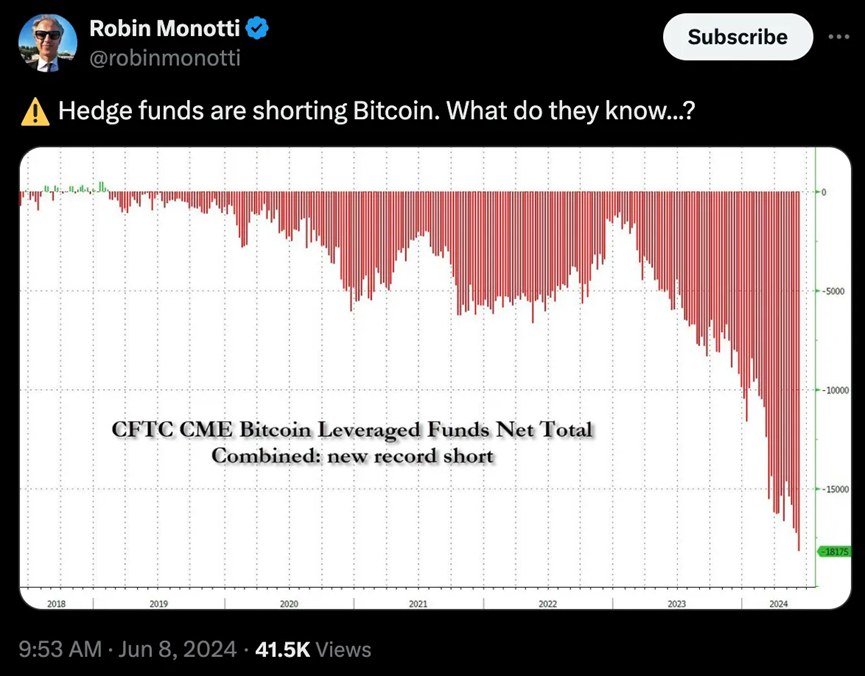
“What if the massive lev of low funding is the lev of this cycle and is already here?” — Kamizak ETH
A possible explanation is that hedge funds are buying spot and short BTC with a 15%-20% delta neutral strategy.
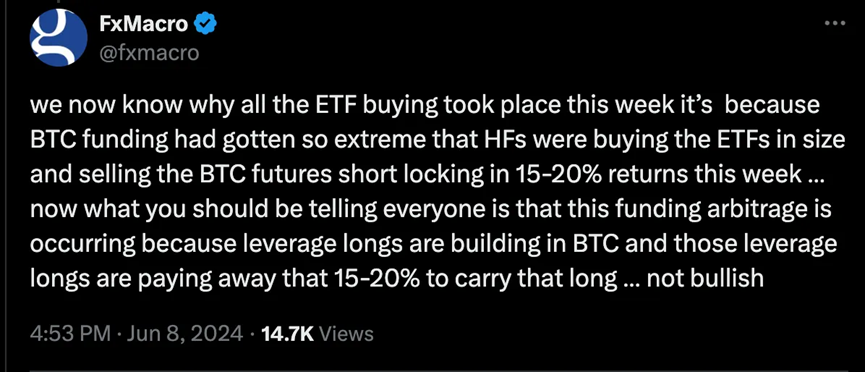
The strategy is the same as Ethena. "What if the massive lev of low funds is the lev of this cycle and it already exists?" - Kamizak ETH
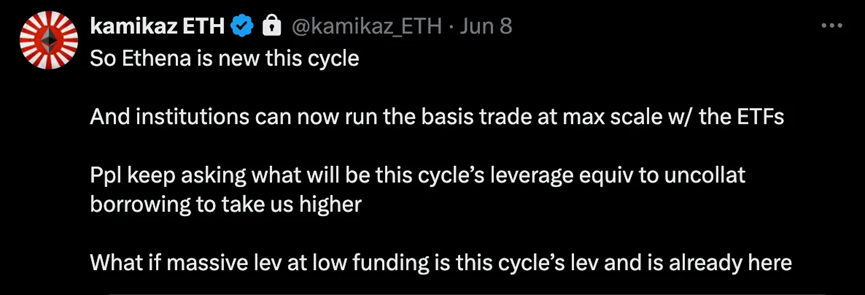
What happens when funding turns negative (when degens are no longer bullish and close their positions)?
When these positions need to be closed, will Ethena (mostly retail users) and spot BTC + short CME futures (mostly institutions) cause a major crash?

Scary. But perhaps there is a simpler answer: institutions are earning positive price arbitrage (currently 2.3%) between different BTC spot and BTC futures.
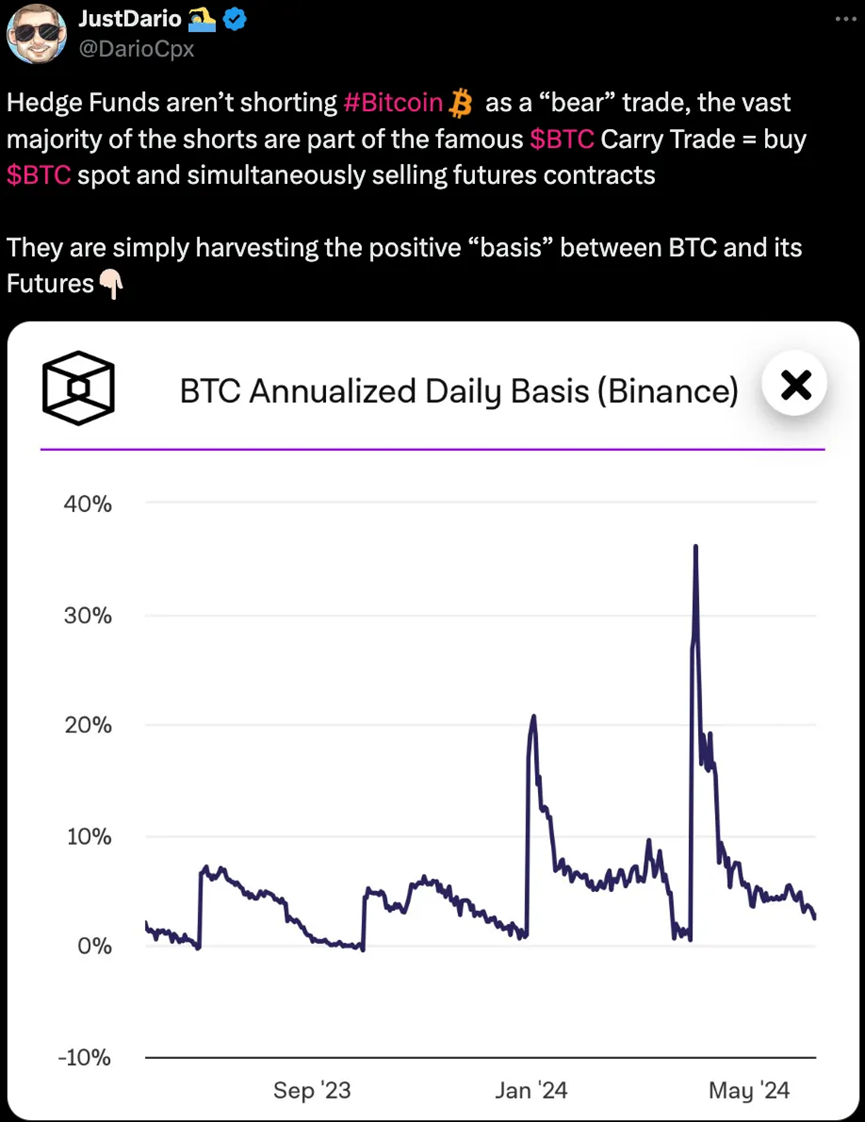
Regardless, these new dynamics with spot ETFs need to be closely watched, as often “risk-free” arbitrage ends up being “riskier” than initially thought.
4. Gamification of Points Mining
Our points addiction is getting worse and worse, but we don’t know how to stop it.
Protocols need credits to attract an initial user base. They also help boost adoption statistics to achieve higher valuations.
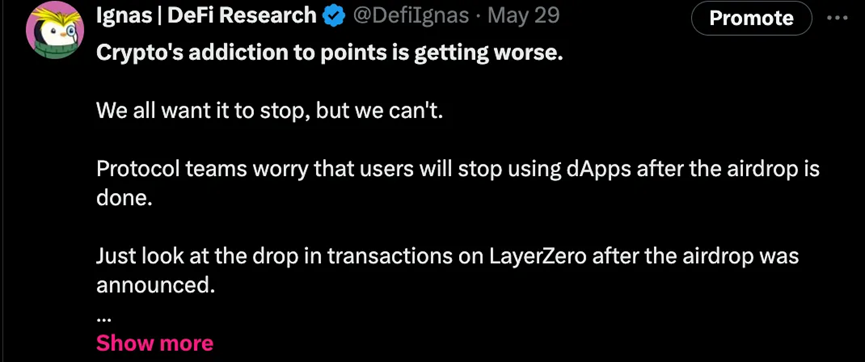
We were tired of points but had no better options.
Instead, I noticed a trend towards gamification of points that added an extra element to the boring point mining strategy.
Sanctum introduces Wonderland, where you can collect pets and earn experience points (EXP) to level them up. As a community, you'll need to band together to solve quests.
It’s not too different from other points programs, as your airdrops are largely based on your deposited SOL, but… the community loves it!

Sanctum's promotional campaign for the first season lasted only a month, which also boosted the game's popularity.
Blackwing has also added an interesting element to the credits airdrop. You can trade the credits (BXP) you earn (from deposits) to Blackwing’s testnet USD (BUSD) and trade it on the platform to earn more BXP.
If you are good at trading, you have the potential to receive a higher airdrop allocation than whales who simply deposit assets.
I’d like to see 0-to-1 innovation in airdrop mining, but even with a little fatigue, our dependence on them is too strong.
Instead, I’d like to see more gamification attempts to bring some fun into mining.
5. Counter-trend of low circulation and high FDV issuance
Everyone hates low circulation, high fdv issuance. Except for VCs and teams, which can sell for a higher price. There are also airdrop farmers, who have more airdrop money.
But retail? No, 26 of the 31 coins Binance recently listed are in the red.
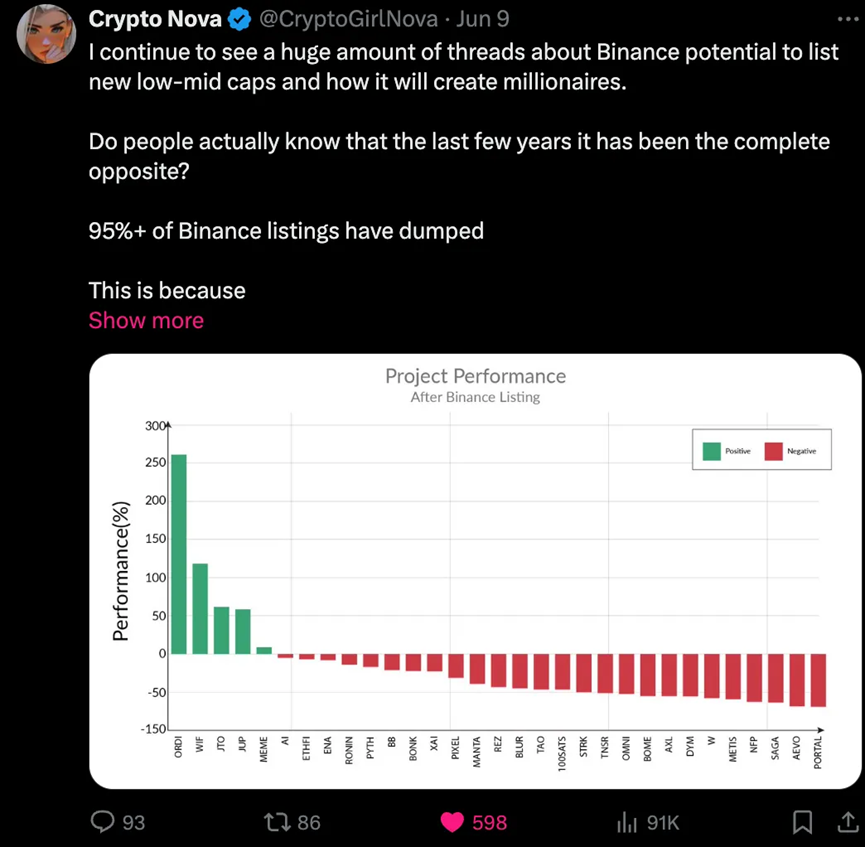
Binance used to be the place to buy the hot new token, but that’s no longer the case. CEX listings are sell-on-news and cash-out events.
Not surprisingly, Binance recently announced the listing of tokens at modest valuations, prioritizing community rewards over internal distribution.
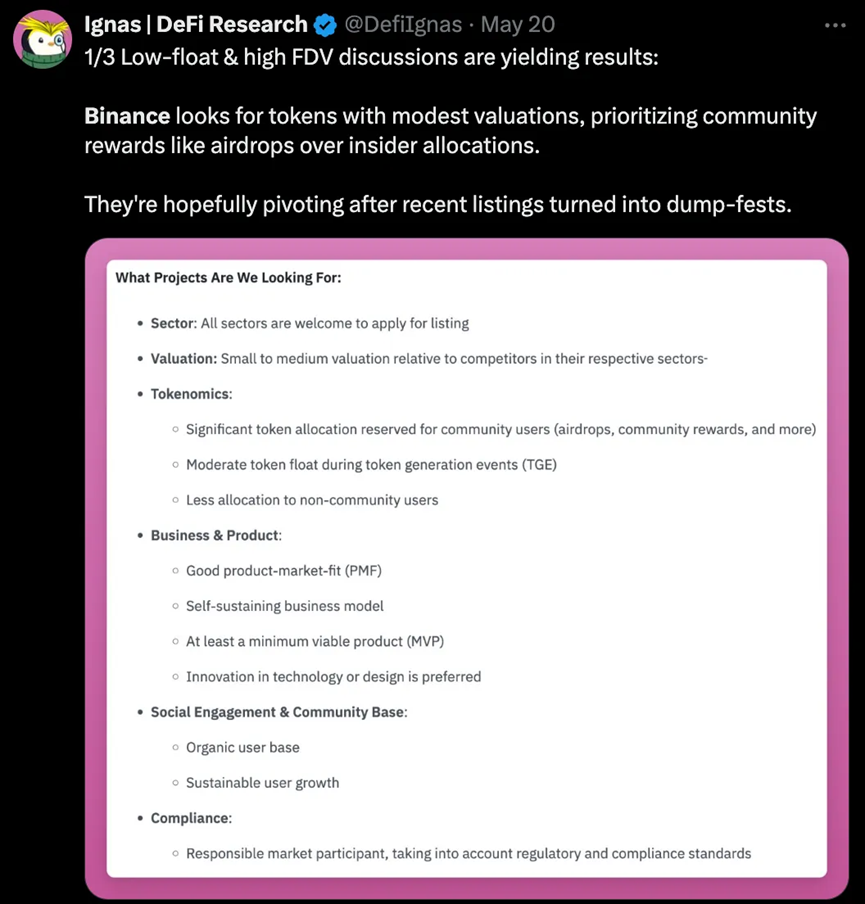
We still need to see words turn into action, but it would be a step in the right direction.
VCs have also been blamed. Large VC investments, once seen as a positive sign, are now viewed by the crypto community as value extraction. The concern is that VCs aim to profit by selling off large assets they acquired at minimal cost.
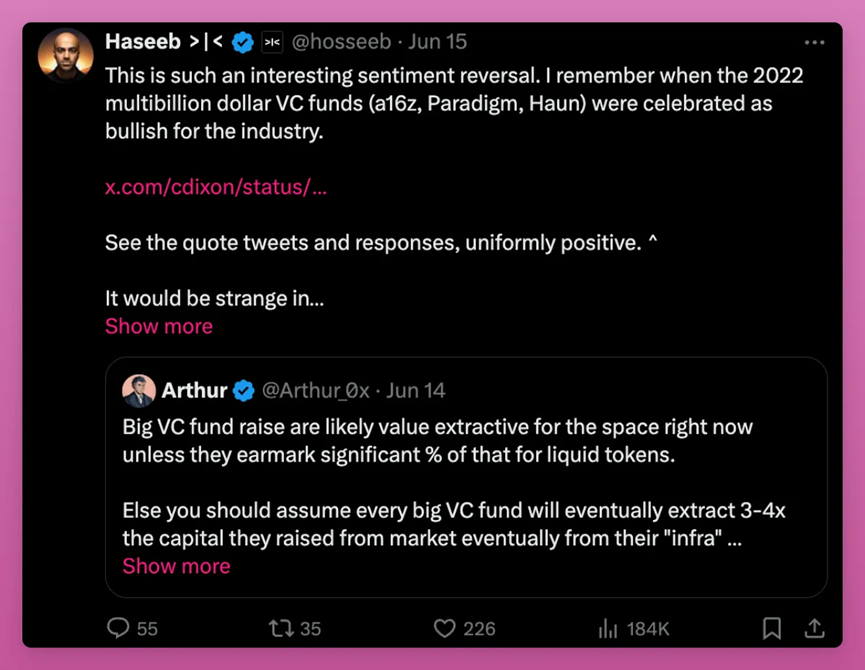
The project team must also take action to avoid a price chart that is forever falling.
There are also more experiments on the protocol side. For example, Ekubo on Starknet distributed one-third of its tokens to users, one-third to the team, and one-third sold by the DAO over a two-month period.
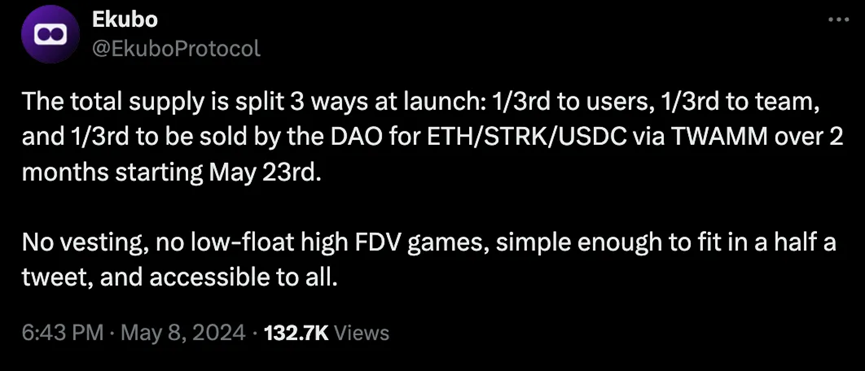
Not everyone likes the idea of a 2 month dump, but it is a token sale to the community, similar to ICOs of the past.
Similarly, Nostra (also on Starknet) launched NSTR at 100% FDV, with 25% allocated via airdrops and 12% sold during the liquidity launch pool event.
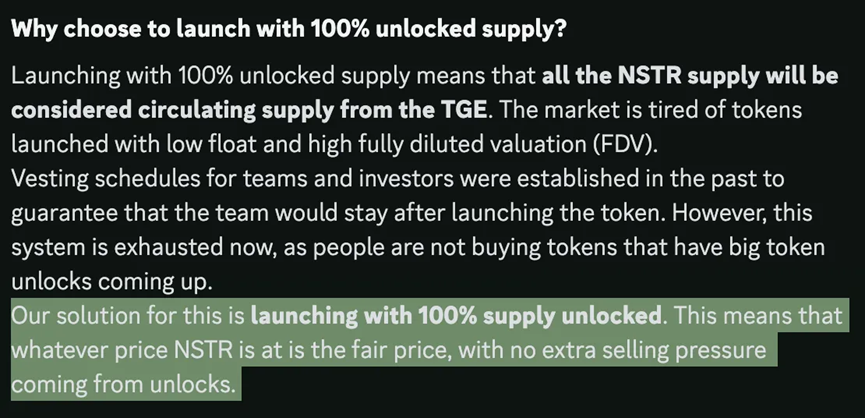
They call it the fairest launch in DeFi, but it introduces the concerns that led to low circulating tokens in the first place (teams, VCs cashing out early and exiting early). Nostra says team and VC tokens will be tokenized on-chain.
If you see them selling, it’s best to help them sell too.
We also ran a 100% airdrop experiment with Friendtech, where Bitcoin Runes were mostly minted by the community for free (although Runes also allowed pre-mining).
What will the outcome be? Uncertain. But there are areas of hope.
Keep an eye out for new token issuance models — a new successful issuance type could become the new dollar of this bull run. If you spot some, please share them in the comments.
6. McKinsey enters DeFi
DeFi supports self-sovereignty, allowing you to effectively own and use your assets regardless of national borders.
But DeFi has gotten really complicated! There are so many strategies to choose from, and their complexity increases when we want to squeeze every % out of it.
Furthermore, managing these increasingly complex protocols requires specific knowledge.
As a result, consulting firms like TradFi have sprung up to help protocols deal with security, governance, and optimization issues. The most famous case is Gauntlet, which charges millions of dollars per year for its clients.
More importantly, DeFi protocols are adapting, allowing the McKinsey of DeFi to manage user assets or/and externalize risk management.
Morpho Blue’s permissionless lending allows the McKinsey of DeFi to create markets for any asset and risk parameters without relying on governance.
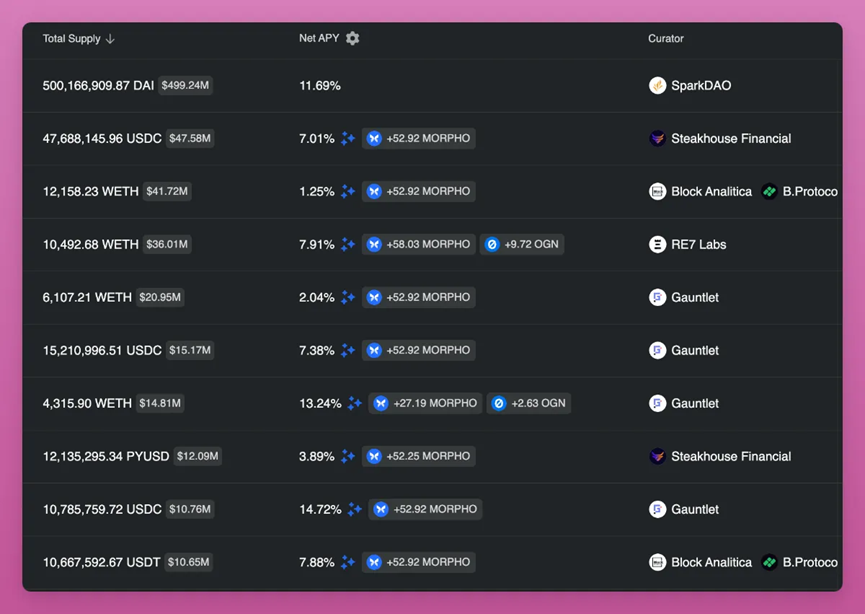
Morpho Blue
The most popular vaults are managed by Gauntlet, Steakhouse, RE7 Labs, and others.
Similarly, Mellow Protocol launched LRTs managed by “curators,” giving “depositors greater flexibility in their desired level of exposure while still benefiting from the liquidity of the staked assets.”

I believe this trend will grow as DeFi complexity increases and further drive “DeFi” towards “on-chain finance”.
What does this mean? One is that power is transferred from token holders to professional companies. Will it make the token less desirable? Or more attractive, as McKinzeys to DeFi help grow the protocol in a professional way and increase revenue generation for the DAO. I don’t know yet.
7. DeFi similar to Web2
I like this very much.
While Friend’s technology may have issues, it has successfully promoted Privy, which can create and manage wallets using Web2 accounts.

During the NFT craze, I helped friends buy NFTs on OpenSea. Teaching how to use Metamask was such a pain.
But now, you can create a wallet on Opensea with just an email and a 2FA code. Seriously, go try it. Took me a minute.
Fantasy Top is leveraging Privy and other user-facing applications.
This trend isn't limited to Privy.
Infinex, developed by Synthetix, allows creating wallets using Passkeys, so you only need to use a password manager for your wallet.
Coinbase has launched a Smart Wallet that can pay gas fees on behalf of users, support batch transactions, and allow wallet creation using Web2 tools.
Now, complex user logins are no longer an excuse for lack of crypto adoption. We just need unique consumer applications.
That’s it for now. Have you noticed any new trends in cryptocurrencies? Let me know in the comments!







